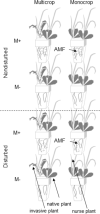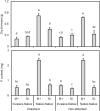Arbuscular mycorrhizal fungi favor invasive Echinops sphaerocephalus when grown in competition with native Inula conyzae
- PMID: 33219310
- PMCID: PMC7679399
- DOI: 10.1038/s41598-020-77030-0
Arbuscular mycorrhizal fungi favor invasive Echinops sphaerocephalus when grown in competition with native Inula conyzae
Abstract
In a globalized world, plant invasions are common challenges for native ecosystems. Although a considerable number of invasive plants form arbuscular mycorrhizae, interactions between arbuscular mycorrhizal (AM) fungi and invasive and native plants are not well understood. In this study, we conducted a greenhouse experiment examining how AM fungi affect interactions of co-occurring plant species in the family Asteracea, invasive Echinops sphaerocephalus and native forb of central Europe Inula conyzae. The effects of initial soil disturbance, including the effect of intact or disturbed arbuscular mycorrhizal networks (CMNs), were examined. AM fungi supported the success of invasive E. sphaerocephalus in competition with native I. conyzae, regardless of the initial disturbance of CMNs. The presence of invasive E. sphaerocephalus decreased mycorrhizal colonization in I. conyzae, with a concomitant loss in mycorrhizal benefits. Our results confirm AM fungi represent one important mechanism of plant invasion for E. sphaerocephalus in semi-natural European grasslands.
Conflict of interest statement
The authors declare no competing interests.
Figures




Similar articles
-
AM fungi facilitate the competitive growth of two invasive plant species, Ambrosia artemisiifolia and Bidens pilosa.Mycorrhiza. 2018 Nov;28(8):703-715. doi: 10.1007/s00572-018-0866-4. Epub 2018 Sep 15. Mycorrhiza. 2018. PMID: 30220052
-
Common mycorrhizal networks influence the distribution of mineral nutrients between an invasive plant, Solidago canadensis, and a native plant, Kummerowa striata.Mycorrhiza. 2019 Jan;29(1):29-38. doi: 10.1007/s00572-018-0873-5. Epub 2018 Nov 12. Mycorrhiza. 2019. PMID: 30421153
-
Disturbance reduces the differentiation of mycorrhizal fungal communities in grasslands along a precipitation gradient.Ecol Appl. 2018 Apr;28(3):736-748. doi: 10.1002/eap.1681. Epub 2018 Mar 5. Ecol Appl. 2018. PMID: 29314434
-
[Interactions between invasive plants and arbuscular mycorrhizal fungi: a review].Ying Yong Sheng Tai Xue Bao. 2011 Sep;22(9):2457-63. Ying Yong Sheng Tai Xue Bao. 2011. PMID: 22126062 Review. Chinese.
-
Diet of Arbuscular Mycorrhizal Fungi: Bread and Butter?Trends Plant Sci. 2017 Aug;22(8):652-660. doi: 10.1016/j.tplants.2017.05.008. Epub 2017 Jun 13. Trends Plant Sci. 2017. PMID: 28622919 Review.
Cited by
-
The Invasion of Galinsoga quadriradiata into High Elevations Is Shaped by Variation in AMF Communities.Plants (Basel). 2023 Sep 6;12(18):3190. doi: 10.3390/plants12183190. Plants (Basel). 2023. PMID: 37765354 Free PMC article.
-
Invasive and Native Plants Differentially Respond to Exogenous Phosphorus Addition in Root Growth and Nutrition Regulated by Arbuscular Mycorrhizal Fungi.Plants (Basel). 2023 Jun 1;12(11):2195. doi: 10.3390/plants12112195. Plants (Basel). 2023. PMID: 37299174 Free PMC article.
-
Arbuscular mycorrhizal fungi improve the competitive advantage of a native plant relative to a congeneric invasive plant in growth and nutrition.Ecol Evol. 2024 May 21;14(5):e11459. doi: 10.1002/ece3.11459. eCollection 2024 May. Ecol Evol. 2024. PMID: 38774145 Free PMC article.
-
Arbuscular mycorrhiza can be disadvantageous for weedy annuals in competition with paired perennial plants.Sci Rep. 2022 Dec 1;12(1):20703. doi: 10.1038/s41598-022-24669-6. Sci Rep. 2022. PMID: 36456609 Free PMC article.
References
-
- Smith SE, Read DJ. Mycorrhizal Symbiosis. Amsterdam: Academic Press; 2008.
-
- Allen MF. Mycorrhizal fungi: highways for water and nutrients in arid soils. Vadose Zone J. 2007;6:291–297. doi: 10.2136/vzj2006.0068. - DOI
Publication types
MeSH terms
LinkOut - more resources
Full Text Sources

